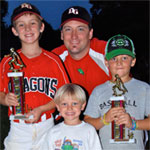Pitching Fundamentals
Pitching obviously is an extension of throwing. Therefore, first things first. Teach the kids how to throw properly first, then move on to pitching mechanics. As with hitting, the pitching motion is very complex and requires the kids to be able to control their bodies and sync up their upper and lower bodies to produce a consistent motion, which in turn will produce more velocity and more consistent throws. When one part gets ahead of or behind the other, undue stress will be placed on the throwing arm and can cause injury or pain to the pitcher. This can also lead to a loss of velocity and erratic throws.
- Grip
- 4-seam grip
- 2-seam grip
- Stretch position
- Pivot foot against front side of rubber.
- Legs spread a little further than shoulder width and in line with catcher.
- Ball in hand.
- Set Position
- Pivot foot against front side of rubber.
- Feet a little closer than shoulder width and in line with catcher or stride foot slightly in front of pivot foot.
- Slight bend in both legs.
- Ball in glove at chest height in middle of body.
- Elbows down.
- Leg Lift
- Stride foot knee comes up to rear ear and thigh is parallel to the ground.
- Foot directly beneath knee.
- Hand Break/Initial Stride
- Hands “Push” Stride knee down.
- Stride foot comes straight down.
- Lead with the front hip.
- Hands break with palms facing away from each other.
- Stride
- After stride foot comes straight down, it now goes out toward catcher.
- Hands continue to separate.
- Glove “Follows” front foot.
- A controlled fall
- Stride Landing
- At stride landing, pitcher’s whole front side is in line with catcher: Glove, elbow, shoulder, hip, foot.
- Stride foot should be slightly closed.
- Glove side palm will be facing catcher with lead arm not fully extended.
- Upper throwing arm and upper glove side arm in line with catcher and parallel to the ground at shoulder height.
- Arms with equal bend in them.
- Ball facing either to the side or behind with fingers on top.
- As in hitting, stride to a balanced position.
- Delivery
- Back hip will start the rotation.
- Glove will pull into chest, palm up.
- Keep throwing elbow parallel to the ground.
- Fingers on top of the ball.
- Follow Through
- Throwing arm finishes outside of glove side knee.
- Pivot leg comes off the ground and finishes even with glove side foot.
Baseball Zone’s Memberships give you access to more information on the fundamentals of hitting, troubleshooting hitter problems as well as tons of information on pitching, defense and training.
Baseball Zone’s Practice Planner makes creating practice plans quick and easy. With over a hundred different drills to choose from, creating a well thought out plan is only a few clicks away.

